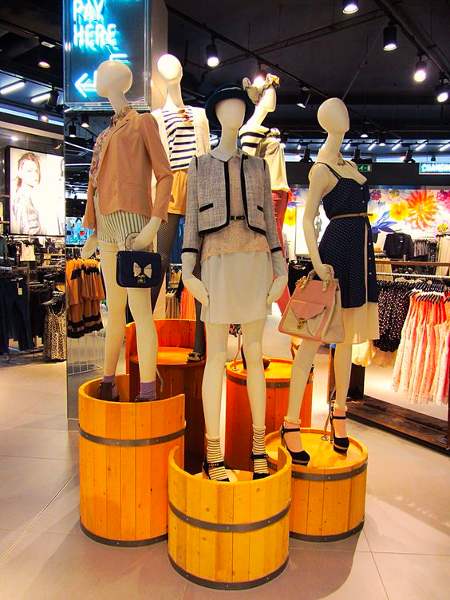Retail store design is everything a retailer does to set up their space when running a retail business. This includes determining the store layout, displaying products, and merchandising. The best retail store design is powerful and, if implemented well, can help grow your business and drive sales. Done poorly, on the other hand, it can be a real detriment and drive shoppers away.
This article lists the most effective retail design ideas, along with tips and tricks to help you master the art of store design, avoid the pitfalls that drive people away, and maximize your space.
Featured Partner
1. Leverage your floor plan for product positioning
Before you delve into aesthetics, you have to lay your groundwork and select a store layout that will serve your business. Your store layout is the strategic arrangement of permanent fixtures within a store designed to create a positive shopping experience and encourage purchases.
You must define the needs and goals of your store layout at the onset of your design process so that you can implement something that makes sense for your business. Here are some ideas:
Use grid floor plans for shelves
For example, a grocery store might implement a grid layout (shown below) designed to hold and organize as many products as possible and facilitate an easy shopping experience.


Grocery store layouts utilize parallel aisles. (Source: The Kitchen)
The grid layout, with parallel aisles, is perfect for stores that stock many items, like groceries, books, toys, or hardware. Think of stores like Target or Trader Joe’s — easy to navigate and shop efficiently. Ensure aisles are wide enough to avoid crowding.
Approach your space as a gallery
An angular floor or free-flow/mixed floor plan (shown below) can showcase curated or edited inventories in designer or specialty shops. This works well for designers, artisans, high-end apparel and accessories retailers, and curated or limited collections. It can also apply to mixed-use stores like bakeries that also display packaged goods.


A boutique, for example, might want to display fewer, curated items and create a more explorational shopping experience, similar to what it may feel like browsing through an art gallery.
Related: 15 Easy & Eye-catching Boutique Decor Ideas to Try
Use a loop floor plan to maximize wall space
A loop floor plan (shown below) helps maximize wall space and lead shoppers along a set pathway. It’s ideal for stores selling apparel, accessories, toys, homeware, kitchenware, personal care products, and specialty retail items.
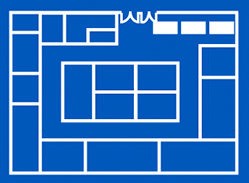
Ikea is a great example, using this layout to maximize product visibility and sales opportunities.
2. Set your store up for showrooming
Showrooming is when you use your physical retail space to display products. Customers may or may not make the purchase in-store. In many cases, in-store purchases are fulfilled at a later date (often via delivery).
This model is typical for furniture stores, home decor, and experiential retailers. Forced-path floor plans (shown below) work well in these scenarios, guiding shoppers through a predetermined path to expose them to every product.
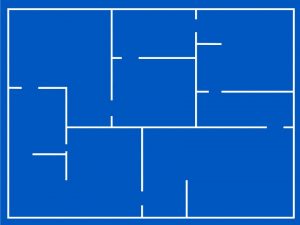
IKEA is the perfect example of a retail store that has perfected the showrooming technique. (Source: Pinterest)
Related: Showrooming & Webrooming: Retailers’ Guide
3. Show what goes on behind the scenes
Give shoppers a peek into how your products are made. LEMLOREN, a high-end designer fashion boutique in Aguada, Puerto Rico, is more than just a retail store. It also offers workshops and classes for those interested in learning more about fashion design and how to sew. In fact, most of its designs are handmade on-site.
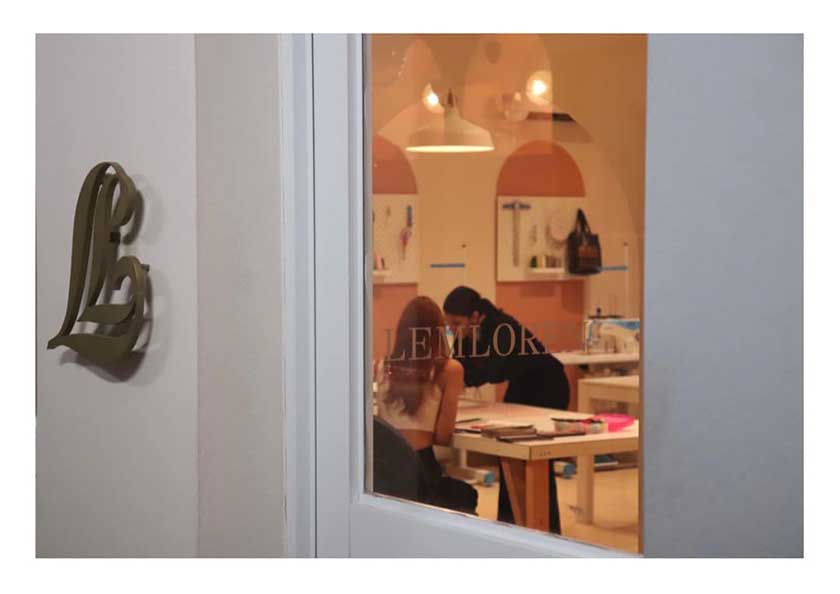
Shoppers who visit the store can peer into the classroom and see what goes into making the apparel they see for sale on the hangers and racks. (Source: Lemloren Facebook page)
View this post on Instagram
4. Reinforce your brand with a theme
Design your store to evoke a theme that aligns with your brand image so that your design reinforces your brand. You want to be sure that your brand, or the emotions and ideas associated with your business, is reflected in your design. A disconnect between design and brand will confuse customers, make them unsure about what they can expect from you, and ultimately deter their loyalty and spending.
Additionally, when your brand and store design coordinate, you can strengthen customers’ ability to identify and connect to your brand and business. This alignment will drive your sales and improve customer experience and perception.
Missouri’s Bass Pro Shops has designed its store with an extensive outdoor theme that is very relevant to its brand. Its over-the-top design perfectly aligns with its brand image and has helped raise the shop’s bottom line and make it one of the state’s top tourist attractions.
All of Bass Pro Shop’s design choices help create a sense of nature and the outdoors, ideas at the heart of its brand. (Source: Pinterest)
5. Create eye-catching creative window displays
Create exterior appeal — your retail design starts outside with your window displays. It creates the first impression and should entice passersby into your store. The goal of your store’s exterior design is to entice people who walk by and drive them into your store to make a purchase.
Be bold with your exterior design, and give people a taste of what they can expect from your business. Be sure you have clear and legible signage, and consider advertising sales on your windows or even setting up a sale table or rack outside your storefront. Design your window displays to engage passersby.
A seating area outside your store invites passersby to spend time with your store.
Anthropologie always creates their exterior designs that extend beyond their window displays.
6. Give the illusion of a larger space to look and shop around
Make your store appear larger to give the illusion of extra space and improve customer experience. Here are some small retail space ideas:
- Paint an accent wall
- Use light colors for walls and furniture
- Incorporate a few and small fixtures and furniture items
- Use mirrors
- Utilize glass elements
- Place decor pieces high up to save floor space and elevate the room
This retail store used light colors throughout the store to make its space look larger to draw attention to its small-sized products.
7. Grab attention with digital signage
Digital signs use LCD, LED, and Projection to display digital images, video, streaming media, and information. Because digital signage is still a new merchandising technique, it is a great tool to engage customers.
Digital signs are sure to attract attention, so place them strategically. Positioning them in front of your store or window displays will help grab attention and lure foot traffic. Placing your digital signs in the back of your store, on the other hand, will draw existing customers’ eyes there and encourage them to come for a closer look.
Under Armour has pick and learn station that lets shoppers see different designs of a product.
An interactive digital art installation for a LEGO store.
8. Add QR codes
Put QR codes on products or shelf tags so customers can access product information, launch chats, play videos, or seamlessly transition an in-store shopper to an online ecommerce platform.
QR codes can also be used to reveal discount codes, sign up for newsletters or product notifications, share contact information or social media platforms, or show store or product locations.
Additionally, you can use QR codes to engage with your customers and promote purchases. For example, consider placing them on your store windows to catch the attention of people passing by or around items with lots of user information that can be pulled up on the web.
Nike uses QR codes to encourage their customers to download their app.
Related:
- 8 QR Code Marketing Ideas for Small Businesses (+ Examples)
- 10 Best QR Code Generators (Cheap or Free)
9. Use displays to make your products shine
Displays are an excellent tool for showcasing products. When done properly, they can save space, keep your store organized, and make products more enticing to your customers. For example, you can use displays to take up vertical space, consolidate products, create endcaps, or fill tables and counter spaces. You can even use temporary POP (point-of-purchase) displays.
Avoid going overboard. Too many or oversized displays can be visually overwhelming and distract from the products instead of highlighting them. Break your store into logical zones and limit your displays to one per zone. Additionally, consider how your customers are browsing and navigating your store so that you leave enough space for easy shopping.

Displaying products on your walls is a great way to maximize your space. (Source: Pinterest)
Related: What’s the Difference Between POP vs POS?
10. Create focal points
Focal points are decorative centerpieces in your store that tend to be placed in key sightlines, such as at entrances, in critical areas, or within window displays. They work to anchor your space visually and provide visual direction to customers. Focal points can look like a cluster of mannequins or a POP display, but they are necessary to create a visually exciting store and engage customers.
Think of your focal points as stepping stones for your store. Shoppers will instinctively gravitate toward them due to their visual appeal, so these points of interest will naturally guide people through your space. Place your focal points at all the areas you want customers to travel to, and ensure they reflect the products and services in their designated spots.
Here are some tips for your focal points:
- Use bright colors: Using colors that are different from or brighter than the rest of your store’s palette will help draw the eye.
- Utilize height: People’s eyes automatically gravitate toward high points, so use height to create a visual draw.
- Be creative: Focal points do not necessarily have to be shoppable, so get creative with your displays.
- Add dramatic lighting: Spotlights, uplighting, and contrast lighting will help create more visual appeal and draw the eye.
- Break up monotony: If there is an area of your store that lacks diversity, use a focal point to create a more interesting look and draw customers in.
Here are a few great examples of focal point displays that create visual interest and act as touchstones to guide shoppers through a space.
11. Avoid displaying too much product
Clutter is the worst enemy of store design. It interferes with shoppers’ ability to visually and physically move through your space and can make finding items difficult. Plus, a messy store can give the impression your brand is neglectful and disorganized.
To avoid the pitfalls of an overcrowded store, you should first determine the right amount of product for your space and business type. In general, higher-end stores should display fewer products and leave more unused floor space, as this will increase the perceived value of the merchandise. On the other hand, big-box or bargain stores should make use of every inch of space they have, as this will reinforce the perception that shoppers are getting a deal.
This boutique shows only a few pieces to increase their perceived value. (Source: Pinterest)
12. Use products as decor
One of the best ways to maximize the amount of merchandise on your floor without creating clutter or spending money on store decoration is to use your products instead. For example, at my boutique, we color-coordinated clothing on our racks, placed our candles on shelves in appealing patterns, and used hooks to hang hats on our walls and create wall displays.
The Design Museum’s shop items can stand as the store’s main decoration because of the way they are arranged by color.
Back-to-school products are strategically displayed in this retail store.
The biggest thing you will need to be careful of is balancing visual appeal with the shopability of the products. Pay attention to how high you place your products and if people are inclined to shop your displays or are hesitant to disturb them.
Consider which items in your store could function as decor, playing with different arrangements to see if they promote shopability and design interest. You can also look to Pinterest for inspiration on product-based decor for shop design ideas.
13. Get the right lighting
Lighting can make or break a retail store. Using adequate and smart retail lighting will make the rest of your design visible to customers and set the backdrop for everything else in your store.
In general, there are four types of retail store lighting, and you should be utilizing them all to ensure your space is well-lit and that you are maximizing and guiding visibility.
- Ambient lighting: The main lighting source for your store and the backdrop on which you will layer other kinds of lighting. Ambient lighting should reach every corner of your space.
- Accent lighting: Used to highlight specific products or key areas, indicating their importance and drawing the eye. Accent lighting helps to guide customers to key products or areas by increasing their visibility or accentuating them.
- Task lighting: Supplemental sources that illuminate where tasks are being done, like at your register or in fitting rooms.
- Decorative lighting: Lighting features that serve an aesthetic rather than utilitarian purpose. Decorative lighting can be used to add embellishment to your space or to add to the ambiance of your storefront.
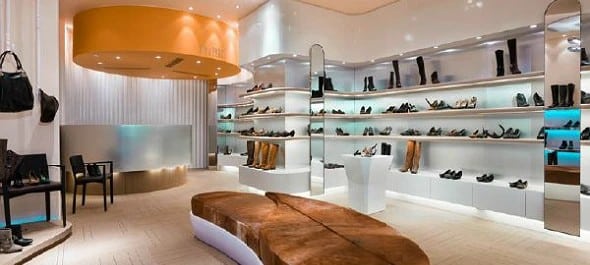
This shoe store uses lighting to keep the space lit, draw attention to key products, and set a relaxed and bright ambiance. (Source: Shopify)
Related: How to Select & Design Retail Lighting in 6 Steps
14.Create picture-worthy elements to build your online presence
Picture-worthy store features will encourage social shares or organic promotions done by real people sharing with their personal audiences. Features like a plant wall, a fun light display, large mirrors, an accent wall, lit signage, or items that people can use for props are great ways to get shoppers to snap photos and share your business on social media.
When placing your photo area, you want to put your design feature toward the back of your store to force people to walk through your entire space to arrive at the picture spot. You also want to be sure that you allow for plenty of photographing space. If you don’t have room inside your storefront, consider putting your photo op feature outside.
Take the Paul Smith store in Los Angeles, for example. The art gallery’s famous Pink Wall has driven millions of visitors, making it a staple photo and shopping destination for tourists and influencers alike.
Tourists pose at the iconic pink wall for a photo op.
Part bookstore and part art gallery, The Last Bookstore also uses store design to create an Instagram-worthy space. Its arch of books and overall photo-ready appeal has made The Last Bookstore one of the most shared bookstores in the world on social media.
A book arch in The Last Bookstore creates a dramatic design feature.
Create spots in your store that can generate organic photo opportunities for customers. These days, it’s all about user-generated content. And what better way than designing your store to generate authentic and organic photo opportunities?
Instagram photo props or accents and mirror selfie walls are perfect examples.
15. Adding seating to create a comfortable space
Seating provides people with a place to relax and it can even make them stay longer. In my own experience, partners and friends accompanying the shoppers often occupy the available seating. With a comfy place for their tagging party to sit, the customer was able to spend more time in the store without having to worry or feel rushed.
Think about where people are going to want to sit within your space. Steer clear of entryways, as this creates clutter and interrupts the decompression zone while placing shoppers in front of potentially drafty doorways. Rather, position your seating toward the back of your store to prompt people through your space and provide a place to sit and review shopping decisions.
Think about where people are going to want to sit within your space. Steer clear of entryways, as this creates clutter and interrupts the decompression zone while placing shoppers in front of potentially drafty doorways. Rather, position your seating toward the back of your store to prompt people through your space and provide a place to sit and review shopping decisions.
Also, consider where seating might facilitate easier shopping. For example, if you have fitting rooms, provide seating nearby, so people have a place to sit and review try-on selections. Alternately, if people will be trying on shoes, provide benches near the shoe selection for them to use when lacing up.
Related: Fitting Room Design Tips
16. Showcase local artists to appeal to your community
Partner with local artists in your community and showcase their work in your store. Getting involved in your community and lifting local artists and artisans up is a great way to demonstrate to your customer base that you care about your the people around you and are striving to connect. Plus, it puts your store in front of those artisans’ audiences.
A Colorado organization opened YesPleaseMore, a temporary store featuring locally crafted goods from more than 70 Colorado-based artists and designers.
17. Incorporate wayfinding in large spaces
Wayfinding refers to signage or store design that helps people navigate through a space. In general, you use wayfinding techniques to make your store easier to navigate, share important information, and keep shoppers safe.
Think of a lined pathway, arrows pointing you where to go, or informational maps that help you orient yourself and find your way through a facility — that’s wayfinding. You typically see wayfinding in large spaces, like warehouses or multilevel stores, helping boost product visibility. In smaller storefronts, wayfinding interrupts and distracts from the shopping experience
18. Keep up with the seasons
Evolving with the seasons makes your store appear more connected to the real lives of your customers and allows you to capitalize on seasonal buying potential, such as winter holidays. In general, you’ll want to match your store’s design with each of the four seasons, and then, within that season, add holiday elements as they come.
This retail clothing store tastefully incorporated fall elements while managing to display its product effectively. (Source: Pinterest)
For example, you can do a big store redesign for spring, incorporating flowers, pastels, and other spring-inspired elements. Then, when Easter, Mother’s Day, and St. Patrick’s Day come, you can layer design features for those particular holidays over spring decor. You can sell this more easily with seasonal and holiday-specific decor. Additionally, it keeps your store fresh month over month.
Choose seasonal decor that will last year after year so you don’t break the bank. Versatility across seasons and holidays is key; look for easy-to-style objects such as vases, power walls, and push-pin boards.
19. Complement retail store design with music
Like lighting, the music you select enhances your space’s ambiance and impacts how customers perceive your brand. Additionally, your music choice can become a sales driver when it aligns with your products. Research shows music impacts customers’ perceptions of a business and how long they stay in a store — and, when used appropriately, music can increase purchasing.
However, music shouldn’t be disruptive and should speak to the way you want customers to feel when experiencing your business. For instance, elevator music and pop are going to evoke very different atmospheres and emotions from your customers. Your music choices can even go so far as to impact how long shoppers stay in your store and how your staff feels when working there.
For example, a boutique in a higher-end neighborhood that appeals to moms and older women can play acoustic-style pop at a low volume. Conversely, a store like Abercrombie & Fitch appeals to teenagers, so the trendy brand plays loud pop music that energizes customers and appeals to its younger audience.
20. Cross-merchandise to boost average basket size
Visual merchandising should involve more than pretty product displays. You want to devise a strategy for your merchandising that will help you meet business goals. One goal many retailers share is the aim to increase the average basket size or average transaction value. In other words, smart small store design encourages shoppers to spend more money with them.
One way to do this is with strategic cross-merchandising in your displays. This involves displaying products from different categories together to encourage customers to add these additional items to their purchases.
Stores selling apparel and accessories might display a ready-to-wear outfit on a mannequin meant to promote shoes, a dress, a handbag, and a necklace. This might inspire someone who only intends to buy the dress to add something else to their purchase, seeing how good they look styled together.

This boutique’s display shows outfit ideas using complementary pieces.
Other cross-merchandising retail space design ideas could include displaying milk next to prepackaged cookie dough, sunscreen with face cream, or a sponge with dishwashing liquid.
Related: Visual Merchandising Strategies to Improve Your Store
21. Add the option for self-checkout
Self-checkout is a retail technology that lets shoppers scan, bag, and pay for their items without cashier assistance. These systems reduce wait shoppers’ time, increase their convenience, and empower them with greater control over their shopping, making your retail store more inviting as a place to visit again.
Grocery stores are the early adopters of self-checkout lanes.
Self-checkout lanes are gaining traction, with Zara and H&M designating dedicated spaces for customers who want to checkout on their own.
22. Designate a space for online orders
Click and collect or buy online, pick up in-store (BOPIS) saw a spike with the onset of the COVID-19 pandemic, and buyers continue to take advantage of this convenient shopping option.
Many retailers can design their space with these shoppers in mind. They’re looking for convenience — block off parking spaces, offer a separate checkout line, or even invite those customers to come out back to the warehouse to pick up their orders there — whatever works for your space.
Nordstrom has an aesthetic space designated for order pickups. (Source: Pinterest)
Related:
23. Clear over clever for your storefront sign
While it’s fun to flex your creative muscle, there are some retail storefront design ideas where the adage “clear over clever” rings true. This is very much the case when it comes to your main sign and storefront ideas. While it should have an appealing and on-brand aesthetic, it also needs to be legible and easy to see. After all, this is how people are going to locate your store. It’s important to get this right, as you won’t have many second chances.
Whether it’s backlit, neon, or decal, storefront signs also need to be aligned with your branding — which means your font choices, colors, and design need to in accordance with your branding kit.
Related: How to Choose a Storefront Sign for Your Business in 6 Steps
24. Keep the space flexible and open for experiences and engagement
As more consumers shift their preferences to shopping online, experiential retail has also become increasingly visible in brick-and-mortar shops. Physical stores are no longer just places to transact and buy products but a place to experience them.
So, it’s a good idea to give your customers things they can’t easily see or experience online — and that’s where creating engaging experiences in your stores comes in. Create an inviting, welcoming, and multifunctional space.
Mantra Lovers, a retail boutique with locally curated artisanal goods in Aguadilla, Puerto Rico, uses its space for more than just selling goods. The shop also doubles as a place for yoga classes, reiki healing sessions, and Tarot readings. As such, many of its tables, stands, and displays are on wheels — making it easy to transform the store into a multifunctional venue with a variety of streams of revenue
View this post on Instagram
View this post on Instagram
25. Use virtual fitting rooms
Virtual fitting rooms are mirrors that use augmented reality (AR) or artificial intelligence (AI) to allow customers to virtually try on products without physically touching the items themselves. The technology creates a live image of the customer in the piece of clothing so that they can check its size, style, and fit. This is typically used for clothing, footwear, and beauty products.
Because they’re virtual, these fitting rooms don’t have to be rooms at all. You can place the mirrors anywhere in your store without worrying about privacy or having to create a barrier.
Retail brand Mango has implemented smart fitting rooms in some of its stores, as shown below.
View this post on Instagram
Related: Virtual Reality (VR) in Retail: Guide With Examples
26. Add a gift-wrapping station
Gift wrapping is a great way to offer a value-add for in-store shoppers. This can be a year-round installation or a seasonal Christmas retail display idea. Consider using beautiful but subtly branded gift wrapping to boost brand awareness and recognition.
Bespoke Letterpress has seamlessly done this for its mall kiosk, as shown below. Its gift wrap station has its own section but is designed like the rest of its stations, allowing shoppers to experience and “shop” the bar at the same time.

Source: Instagram
Frequently Asked Questions (FAQs)
Click through the tabs below to know the answers to the most common questions
To decide on your retail store layout, begin by understanding your merchandise and considering available space and customer flow. Then, choose a floor layout — like grid, loop, or free-flow — that best fits your products and encourages comfortable, intuitive shopping.
Enhance your store’s appearance with attractive displays, strategic lighting, and focal points. Regularly refresh your decor by the season, incorporate digital signage, and ensure your store products remain organized and uncluttered.
To decorate a retail shop with limited space, maximize vertical space, and use multifunctional furniture. Other retail shop design ideas include incorporating mirrors, using good lighting, and creating appealing window displays to make your small shop feel larger and inviting.
The four main types of store layouts are grid, loop (racetrack), free-flow, and forced-path. Each layout caters to different products, shopping behaviors, and store sizes.
The best layout depends on your store type and customer needs. Grid layouts work well for stores with large product volumes, while free-flow layouts are ideal for specialty stores that emphasize exploration and unique products.
Bottom Line
Creating a beautiful, on-brand, and engaging retail store design is a key part of starting your retail business. You want to be sure that it fosters a positive customer experience, drives sales, and reinforces your brand. Taking inspiration from the retail store decor ideas outlined above will set you on the right track for creating a store design that is effective and visually appealing so that your business can thrive.
Effective retail design combines creativity, practicality, and customer-focused strategies. Implementing these tips, from strategic layouts and engaging displays to modern technology integration, can significantly enhance the shopping experience, drive customer engagement, and ultimately boost sales for your small business.


